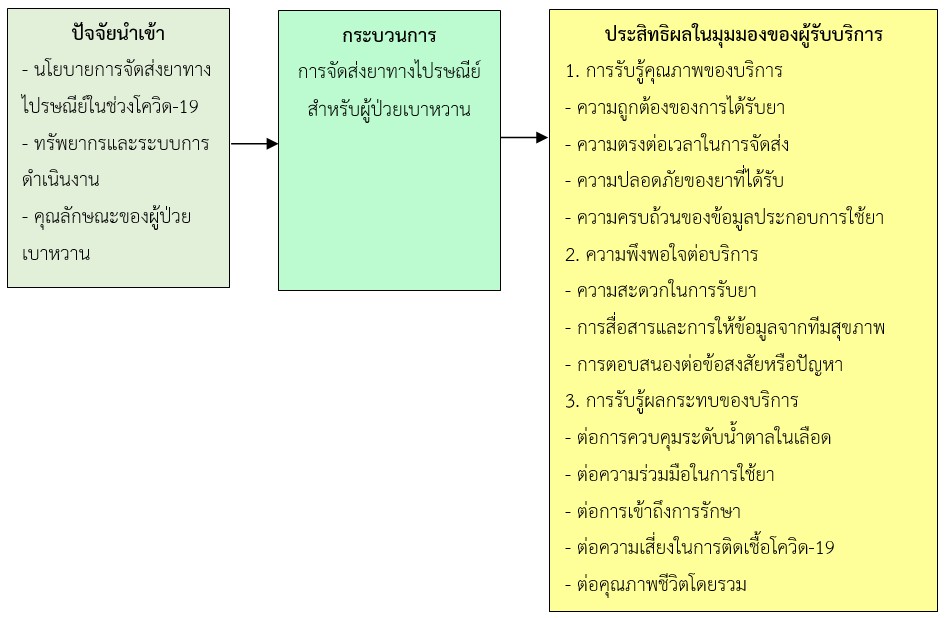มุมมองของผู้รับบริการต่อประสิทธิผลของบริการการจัดส่งยาทางไปรษณีย์ในผู้ป่วยโรคเบาหวานช่วงสถานการณ์การระบาดของโรคโควิด-19
คำสำคัญ:
การบริการจัดส่งยาทางไปรษณีย์, ประสิทธิผล, ผู้ป่วยโรคเบาหวาน, โควิด-19บทคัดย่อ
การวิจัยแบบผสมวิธีครั้งนี้มีวัตถุประสงค์เพื่อศึกษาประสิทธิผลของการจัดส่งยาทางไปรษณีย์ของผู้ป่วยโรคเบาหวานตามการรับรู้ของผู้รับบริการ โดยมีกลุ่มตัวอย่างเป็นผู้ป่วยโรคเบาหวานจำนวน 299 คน ที่รับบริการในโรงพยาบาลของรัฐ 6 แห่ง ข้อมูลเชิงปริมาณใช้แบบสอบถามคุณภาพบริการจัดส่งยาตามมาตรฐานการบริการจัดส่งยาทางไปรษณีย์และข้อมูลเชิงคุณภาพใช้แบบสัมภาษณ์คุณภาพบริการจัดส่งยา ความพึงพอใจและผลกระทบของระบบบริการส่งยาทางไปรษณีย์ วิเคราะห์ข้อมูลเชิงปริมาณโดยใช้สถิติเชิงพรรณนา ข้อมูลเชิงคุณภาพโดยการวิเคราะห์เนื้อหาจัดเป็นประเภท
ผลการศึกษาพบว่า การรับรู้คุณภาพของบริการจัดส่งยาทางไปรษณีย์ตามเกณฑ์การจัดส่งยา ส่วนใหญ่อยู่ในระดับดีมาก โดยเฉพาะในส่วนของความถูกต้องของยาที่ได้รับ ความตรงต่อเวลาในการจัดส่ง ความปลอดภัยของยาที่ได้รับ และความครบถ้วนของข้อมูลประกอบการใช้ยา คุณภาพในการจัดส่งยาที่มีประสิทธิภาพในระดับดี มี 2 ประเด็น คือ การขออนุญาตบันทึกเสียงขณะพูดคุย (Mean = 2.62, S.D. = 1.32) และการได้รับยาฉีดที่มีการรักษาระดับอุณหภูมิที่เหมาะสม (Mean = 2.96, S.D. = 1.32) ด้านผลกระทบเป็นไปในทางบวก พบว่าลดระยะเวลารอคอยยาในโรงพยาบาล ลดค่าใช้จ่ายในการเดินทางมารับยา และลดความเสี่ยงในการสัมผัสโรค ระบบบริการส่งยาทางไปรษณีย์เป็นนวัตกรรมที่มีประโยชน์หากมีสถานการณ์วิกฤต หรือกรณีมีโรคระบาดอื่น ๆ แต่จำเป็นต้องพัฒนากระบวนการจัดส่งให้เป็นไปตามมาตรฐาน ร่วมกับการตรวจสุขภาพทางไกลเพื่อติดตามผลสุขภาพผู้ป่วย
เอกสารอ้างอิง
กองโรคไม่ติดต่อ. (2563). จำนวนป่วยและอัตราตายด้วยโรค NCD. สืบค้นเมื่อ 10 สิงหาคม 2567 จาก http://www.thaincd.com/2016/mission/documents-detail.php?id=13893&tid=32&gid=1-020.
ปิยะวัฒน์ รัตนพันธ์, ประดับ เพ็ชรจรูญ และสิรินยา สุริยา. (2563). ระบบจัดส่งยาทางไปรษณีย์สำหรับผู้ป่วยโรคความดันโลหิตสูง ในสถานการณ์แพร่ระบาดของเชื้อไวรัสโคโรนาสายพันธุ์ใหม่ 2019. เชียงรายเวชสาร, 12(2), 48-66.
โรงพยาบาลพระนครศรีอยุธยา. (2563). ส่งยาถึงบ้านต้านโควิด 19. สืบค้นเมื่อ 10 สิงหาคม 2567 จาก http://www.ayhosp.go.th/ayh/index.php/ayh-home/news-events/new/phayh2021/6306-phayh2021.
วิชิต ตั้งจิตติพร. (2557). โรงพยาบาลศิริราช ส่งยาทางไปรษณีย์ ลดแออัดในโรงพยาบาล. สืบค้นเมื่อ 10 สิงหาคม 2567 จาก https://www.hfocus.org/content/2014/05/7272.
ศรีสุดา งามขำ และบุญเตือน วัฒนกุล. (2565). การวิเคราะห์ผลกระทบของสถานการณ์ระบาดของโรคโควิด-19 ต่อระบบบริการสำหรับผู้ป่วยโรคเบาหวานในประเทศไทย. วารสารสมาคมพยาบาลแห่งประเทศไทยฯ สาขาภาคเหนือ, 28(1), 91-103.
สภาเภสัชกรรม. (2565). ประกาศข้อบังคับสภาเภสัชกรรมที่ 62/256 เรื่อง แนวทางเกี่ยวกับมาตรฐานการให้บริการเภสัชกรรมทางไกล (Telepharmacy) 30 พฤศจิกายน 2565 ราชกิจจานุเบกษา เล่ม 139 ตอนพิเศษ 281 ง. สืบค้นเมื่อ 10 สิงหาคม 2567 จาก https://www.pharmacycouncil.org/index. php?option=content_detail&menuid=68&itemid=2966&catid=0.
สำนักงานหลักประกันสุขภาพแห่งชาติ. (2563). สปสช.จับมือไปรษณีย์ไทยเพิ่มศักยภาพส่งยาสิทธิบัตรทองหนุนการแพทย์ยุคใหม่. สืบค้นเมื่อ 10 สิงหาคม 2567 จาก https://www.nhso.go.th/FrontEnd/NewsInformationDetail.aspx?newsid=Mjg3Mw.
Bertalanffy, L. Von. (1972). The history and status of General System Theory. Academy of Management Journal, 15(4), 407-426. https://doi.org/10.2307/255139
Calton, B., Abedini, N., & Fratkin, M. (2020). Telemedicine in the time of coronavirus. Journal of Pain and Symptom Management, 60(1), e12-e14. https://doi.org/10.1016/j.jpainsymman.2020.03.019
Cochran, W. G. (1977). Sampling Techniques. 3rd ed. New York: John Wiley & Sons.
Hong, Z., et al. (2020). Telemedicine during the COVID-19 pandemic: Experiences from Western China. Journal of Medical Internet Research, 22(5), e19577. https://doi.org/10.2196/19577
Inter Express Logistics. (2565). Fulfillment ยาและเวชภัณฑ์แตกต่างจากสินค้าทั่วไปอย่างไร?. Retrieved August 10, 2024 from https://iel.co.th/fulfillment.
Ito, J., Edirippulige, S., Aono, T., & Armfield, N. R. (2017). The use of telemedicine for delivering healthcare in Japan: Systematic review of literature published in Japanese and English languages. Journal of Telemedicine and Telecare, 23(10), 828-834. https://doi.org/10.1177/1357633X17732801
Leung, R., Guo, H., & Pan, X. (2018). Social media users' perception of telemedicine and mHealth in China: Exploratory study. JMIR mHealth and uHealth, 6(9), e181. https://doi.org/10.2196/mhealth.7623
Low, J. A., Toh, H. J., Tan, L. L. C., Chia, J. W. K., & Soek, A. T. S. (2020). The nuts and bolts of utilizing telemedicine in nursing homes - The GeriCare@North Experience. Journal of the American Medical Directors Association, 21(8), 1073-1078. https://doi.org/10.1016/j.jamda.2020.04.014
Mueller, B. (2020). Telemedicine arrives in the UK “10 years of change in one week.” The New York Times. Retrieved August 10, 2024 from https://www.nytimes.com/2020/04/04/world/europe/telemedicine-uk-coronavirus.html.
Peine, A., Paffenholz, P., Martin, L., Dohmen, S., Marx, G., & Loosen, S. H. (2020). Telemedicine in Germany during the COVID-19 pandemic: Multi-Professional National Survey. Journal of Medical Internet Research, 22(8), e19745. https://doi.org/10.2196/19745
Portnoy, J., Waller, M., & Elliott, T. (2020). Telemedicine in the Era of COVID-19. The Journal of Allergy and Clinical Immunology. In Practice, 8(5), 1489-1491. https://doi.org/10.1016/j.jaip.2020.03.008
Raposo, V. L. (2016). Telemedicine: The legal framework (or the lack of it) in Europe. GMS Health Technology Assessment, 12, Doc03. https://doi.org/10.3205/hta000126
Sood, A., Watts, S. A., Johnson, J. K., Hirth, S., & Aron, D. C. (2018). Telemedicine consultation for patients with diabetes mellitus: A cluster randomised controlled trial. Journal of Telemedicine and Telecare, 24(6), 385-391. https://doi.org/10.1177/1357633X17704346
World Health Organization. (2010). Annex 5 WHO good distribution practices for pharmaceutical products. Retrieved August 10, 2024 from https://www.cls.co.at/media/files/who_gdp_tr957_annex5_cls_co_at.pdf.

ดาวน์โหลด
เผยแพร่แล้ว
รูปแบบการอ้างอิง
ฉบับ
ประเภทบทความ
สัญญาอนุญาต
ลิขสิทธิ์ (c) 2024 วารสารวิจัยการพยาบาลและการสาธารณสุข

อนุญาตภายใต้เงื่อนไข Creative Commons Attribution-NonCommercial-NoDerivatives 4.0 International License.
1. บทความหรือข้อคิดเห็นใด ๆ ที่ปรากฏในวารสารวิจัยการพยาบาลและการสาธารณสุข ที่เป็นวรรณกรรมของผู้เขียน บรรณาธิการไม่จำเป็นต้องเห็นด้วย
2. บทความที่ได้รับการตีพิมพ์ถือเป็นลิขสิทธิ์ของ วารสารวิจัยการพยาบาลและการสาธารณสุข








